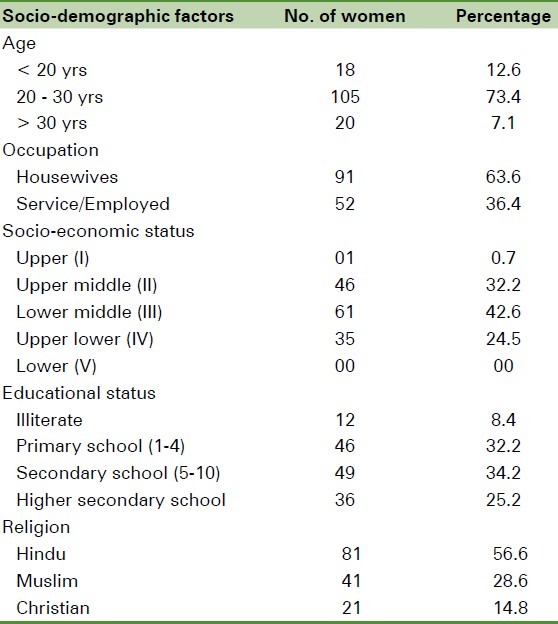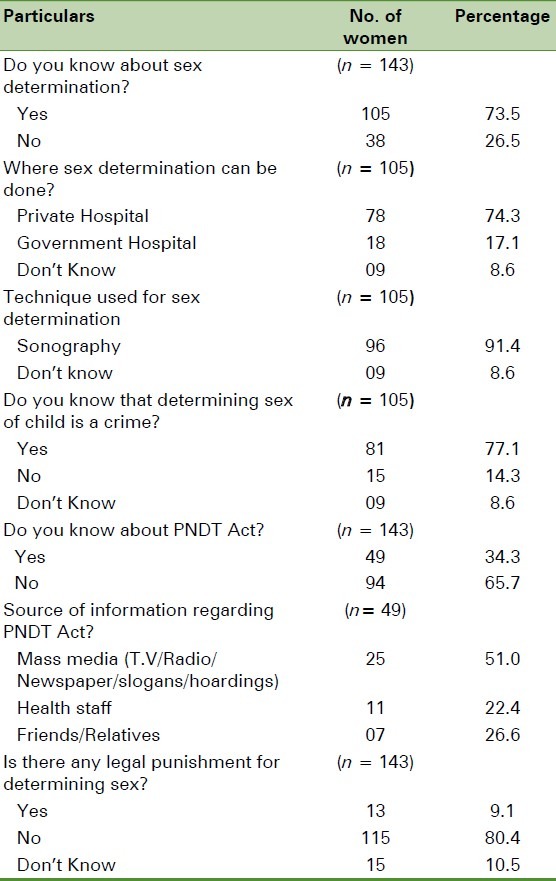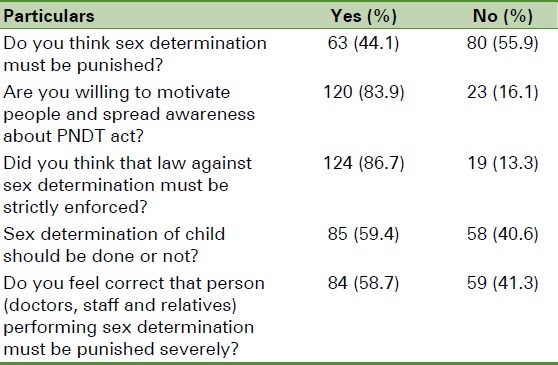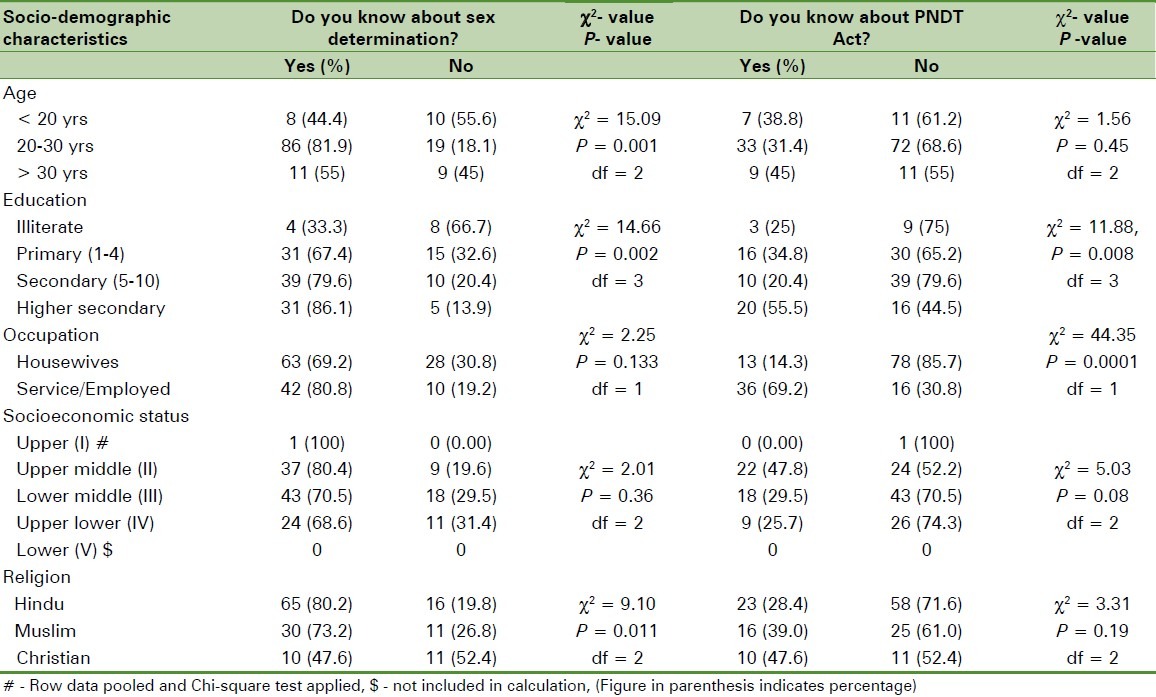Abstract
Background:
Sex ratio, an important social indicator measuring extent of prevailing equity between males and females in society, is defined as number of females per 1000 males. Changes in sex ratio reflect underlying socioeconomic, cultural patterns of a society. As per 2011 census sex ratio in India is 914/1000 males, which continues to be significantly adverse towards women.
Objectives:
This study was conducted to assess the knowledge and attitude regarding Prenatal Diagnostic Techniques (PNDT) Act among the pregnant women at a tertiary care teaching hospital in Mumbai.
Materials and Methods:
A cross-sectional study was carried out in the antenatal ward of Lokmanya Tilak Municipal Medical College and General Hospital, Mumbai during the period of January to April 2008. A total of 143 women were included and a pre-designed and pre-tested questionnaire was used to get information regarding socio-demographic details of the pregnant women. They were asked regarding the knowledge and attitude towards the PNDT Act. Data was analyzed by using Statistical Package of Social Sciences (SPSS) 16.0.
Results:
In the present study, out of 143 women, 105 (73.5%) knew about sex determination. Even out of those who had heard, the correct knowledge regarding PNDT act was very less. Sonography as a technique for sex determination done at private hospital was known to the majority of women.
Conclusion:
Education of women about gender equality and recommendations under PNDT act in order to improve declining sex ratio in our country must be done. Wide publicization in the media of the Act must be scaled up.
Keywords: Attitude, knowledge, pregnant women, prenatal diagnostic technique act
INTRODUCTION
Sex ratio is an important social indicator measuring extent of prevailing equity between males and females in society, is defined as no. of females/1000 males. Changes in sex ratio reflect underlying socioeconomic, cultural patterns of a society. It is mainly the outcome of the interplay of sex differentials in mortality, sex selective migration, sex ratio at birth and at times the sex differential in population enumeration.[1] As per the 2011 census provisional reports, national child sex ratio (CSR) of 914 girls per 1000 boys (children aged 0–6 years) as compared to 927 in 2001. This CSR at India level is lowest since independence. Increasing trend in CSR (0-6 yrs) has been seen in Punjab, Haryana, Himachal Pradesh, Gujarat, Tamil Nadu, Mizoram and A&N islands. In all remaining 27 states/UTs the CSR has shown a decline over Census 2001.[2] Desire for male child manifests so blatantly that parents have no qualms about repeated, closely spaced pregnancies, premature deaths and even terminating child before it is born. Birth of female child is perceived as a curse with economic and social liability.[3] Female foeticide has resulted in decline of child sex ratio, and has led to enforcement of Preconception and Prenatal Diagnostic Techniques Act. In 1994, the Government of India passed the Prenatal Diagnostic Techniques (Regulation and Prevention of Misuse) Act with the aim of preventing female feticide. The implementation of this Act was slow. It was later amended and replaced in 2002 by the Pre-conception and Pre-natal Diagnostic Techniques (Prohibition of Sex Selection) Act without ever having been properly implemented. Contravening the provisions of the Act can lead to a fine of Rs 10,000 and up to three years imprisonment for a first offence, with greater fines and longer terms of imprisonment for repeat offenders.[4] Thus the present study was conducted among pregnant women admitted in antenatal ward to find out the knowledge and attitude regarding the act against sex determination.
MATERIALS AND METHODS
A cross-sectional, hospital based, descriptive study was carried out during the period of January to April 2008 in the antenatal ward of a Lokmanya Tilak Municipal Medical College (LTMMC) and General Hospital, Mumbai. It has its own teaching institute catering to a population coming from all classes of society but predominantly from the middle and lower classes. A study period of four months was considered. All the women admitted during the study period were included, universe being the sample size during the study period. A total of 143 pregnant women admitted in the antenatal ward and who gave the consent for the study during the study period were selected consecutively and interviewed without any prompting. A pre-designed and pre-tested questionnaire was used to get information regarding socio-demographic details like age, education, socio-economic status and occupation of the pregnant women. A pilot study was conducted by using a pre-designed interview schedule to test the validity, applicability and practicability of the interview schedule and to assess the time required for the respondent to answer the questions. According to the answers obtained and the difficulties faced during the pilot study, the proforma was appropriately modified and the method of interview finalized. The final interview schedule so devised was used in the present study. They were asked regarding the knowledge and attitude towards the PNDT Act. Knowledge of PNDT Act was assessed by asking regarding sex determination, the law and its punishment for misuse. Attitude was assessed by asking about the sex determination as a crime and thought of doing sex determination during pregnancy. Information given by the participants and their identity were kept confidential. All the questions were asked in the participant's language or else the meaning was conveyed properly. Ethical committee of the institute approved the study. Data were entered in MS Excel and analyzed using Statistical Package of Social Sciences (SPSS) 16.0. Statistical significance was set at P ≤ 0.05.
RESULTS
It was observed from Table 1 that out of the total 143 women, 105 (73.4%) women were in the age group of 20 to 30 years while 18 (12.6%) were aged below 20 years. Majority of women were housewives 91 (63.6%) and 52 (36.4%) were working women. According to modified B.G. Prasad's Classification,[5] majority 61 (42.6%) belonged to lower middle class followed by 46 (32.2%) belonged to upper middle class, while 35 (24.5%) were from the upper lower class. About 46 (32.2%) had studied up to primary level schooling, 49 (34.2%) up to secondary and 36 (25.2%) up to higher secondary. Maximum women were Hindu 81 (56.6%), followed by Muslim 41 (28.6%) and Christian 21 (14.8%).
Table 1.
Distribution of pregnant women according to socio-demographic characteristics (n = 143)

It was seen from Table 2 that out of 143 women, 105 (73.5%) knew about sex determination while 38 (26.5%) had no knowledge about sex determination.78 (74.3%) told that sex determination can be done at private hospitals and 18 (17.1%) told at government hospitals. Out of 105 women, 96 (91.4%) told that sex determination can be done by sonography. 81 (77.1%) women regarded determining sex of the foetus as crime. Out of total 143 women, only 49 (34.3%) women knew about the PNDT Act. Almost half women, 25 (51%) knew about PNDT Act from the mass media. 115 (80.5%) women didn’t know about the legal punishment for sex determination.
Table 2.
Assessment of the knowledge about PNDT Act among pregnant women

It is evident from Table 3 that out of the 143 women, 63 (44.1%) thought that sex determination must be punished. 120 (83.9%) women were willing to motivate people and spread awareness about PNDT act. 124 (86.7%) women thought that law against sex determination must be strictly enforced. 85 (59.4%) women said that sex determination should be done, while 58 (40.6%) were against it. 84 (58.7%) women were of the opinion that person (doctors, staff and relatives) performing sex determination must be punished severely and 41.3% told that they should not be punished.
Table 3.
Assessment of the Attitude about PNDT Act among pregnant women (n = 143)

It is evident from Table 4 that out of the 143 women, 86 (81.9%) knew about sex determination in the age group 20-30 years while out of them, only 33 (31.4%) knew about PNDT Act. About 9 (45%) above 30 years didn’t know about sex determination (P < 0.01). Knowledge regarding sex determination and PNDT Act was significantly associated with education (P < 0.01). Only 9 (75%) illiterates didn’t know about the PNDT Act, but as education increased, the knowledge about sex determination and the Act increased (P < 0.01). Religion was not found to be associated with the knowledge about Act and sex determination.
Table 4.
Association of Socio-demographic characteristics with the knowledge about sex determination and PNDT Act among pregnant women (n = 143)

DISCUSSION
Skewed sex ratio is an issue of major concern and has long-term social and demographic consequences. India is facing a demographic nightmare in terms of gender imbalance. In the present study, regarding the knowledge of these women on PNDT Act, 105 (73.5%) knew about sex determination while only 49 (34.3%) women knew about the PNDT Act. Similarly a study by Shrivastava S et al.[6] conducted at Bareilly revealed that 80% females were aware of prenatal sex determination and 67% unaware of PNDT Act. A study which was conducted by Ghose S et al.[7] found that 95% of the pregnant women were aware of the availability of a method for intrauterine sex determination. When they were asked whether female foeticide was punishable, 53% of the participants said that they were aware that doing so was punishable under the law. A study by Puri S et al.[8] in slums of Chandigarh showed that only 11.66% of subjects had knowledge where sex determination can be done and 65.5% agreed to the fact that it is a crime, but only 16% were aware that it was punishable under the law. Chavada M et al.[9] had similar findings with 91.1% of urban and 96.4% of rural women were aware of sex determination. Our study showed that 91.4% females told that sex determination can be done by sonography and maximum at private hospitals. Sonography as a technique for sex determination was done at private hospital was known to majority, 90% of women, as evident from Chavada M et al.[9] study. Also they showed that persons who had undergone sex determination were the main source of information. Vadera BN et al.[10] showed that the awareness of consequences of female feticide grew with literacy status. Kansal R et al.[11] also revealed that 84.5% respondents were aware that prenatal diagnostic tests are illegal. A study by Siddharam S et al.[12] in his study, when they were asked regarding the various techniques which were used for prenatal sex determination, 73% participants said that ultrasound was the right modality, 6% said that it was amniocentesis and 19% said that they didn’t know about the techniques.
CONCLUSION
In our study, many women were aware of prenatal sex determination and unaware of PNDT Act and thus wide publicization in the media of the Act must be scaled up. Education of women about gender equality and recommendations under PNDT act in order to improve declining sex ratio in our country must be done. Media must be encouraged to generate mass awareness on sex selective acts and their legal implication.
ACKNOWLEDGEMENT
We express our deep sense of gratitude to the Dr. Daksha Pandit, Professor and Head, Department of Community Medicine, Lokmanya Tilak Municipal Medical College, Mumbai. We also acknowledge the help and support of Department of Obstetrics & Gynaecology, Lokmanya Tilak Municipal Medical College, Mumbai.
Footnotes
Source of Support: Nil
Conflict of Interest: None declared
REFERENCES
- 1.Khanna SK. Prenatal sex determination- a new family building strategy. Manushi. 1995;86:23–9. [PubMed] [Google Scholar]
- 2.Office of Registrar General and Census Commissioner, India. Population in age group 0-6 years by sex and sex ratio (0-6). Census of India, Government of India. 2011. [Last accessed on 2011 Apr 09]. Provisional population totals. Available from: http://www.censusindia.gov.in/2011-prov-results/indiaatglance.html .
- 3.Kanitkar T, Mistry M. Status of women in India - an interstate comparison. Indian J Soc Work. 2000;61:381–3. [Google Scholar]
- 4.Government of India (GOI) The Pre-Natal Diagnostic Techniques (Regulation and Prevention of Misuse) Amendment Act. 2003. [Last accessed on 2012 Apr 14]. www.xiss.ac.in/RCH/Others/PNDT_Act.pdf ; Available from: http://mohfw.nic.in/PNDTAmendments.htm .
- 5.Rao TB. Sociology in Medicine. 1st ed. Guntur: Sree Graphics; 2002. p. 76. [Google Scholar]
- 6.Shrivastava S, Kariwal P, Kapilasrami MC. A community based study on awareness and perception on gender discrimination and sex preference among married women (in reproductive age group) in a rural population of district Bareilly, Uttar Pradesh. Nat J Commun Med. 2011;2:273–6. [Google Scholar]
- 7.Ghose S, Sarkar S. Knowledge and attitude of Prenatal Diagnostics techniques Act among the antenatal women- a hospital based study. J Community Med. 2009;5:1–6. [Google Scholar]
- 8.Puri S, Bhatia V, Swami HM. Gender Preference and Awareness Regarding Sex Determination among Married Women in Slums of Chandigarh. Indian J Community Med. 2007;32:60–2. [Google Scholar]
- 9.Chavada M, Bhagyalakshmi A. Knowledge, Attitude and Practice regarding sex determination among married women- a comparative study between urban and rural area. Indian J Matern Child Health. 2011;13:1–8. [Google Scholar]
- 10.Vadera BN, Joshi UK, Unadakat SV, Yadav BS, Yadav S. Study on Knowledge, attitude and practices regarding gender preference and female foeticide among pregnant women. Indian J Community Med. 2007;32:300–1. [Google Scholar]
- 11.Kansal R, Khan AM, Bansal R, Parashar P. A hospital based study on knowledge, attitude and practice of pregnant women on gender preference, prenatal sex determination and female foeticide. Indian J Public Health. 2010;54:209–12. doi: 10.4103/0019-557X.77263. [DOI] [PubMed] [Google Scholar]
- 12.Siddharam SM, Venktesh GM, Theshwari HL. Awareness regarding gender preference and female foeticide among teachers in the Hassan District, South India. J Clin Diagn Res. 2011;5(Suppl 2):1430–3. [Google Scholar]


